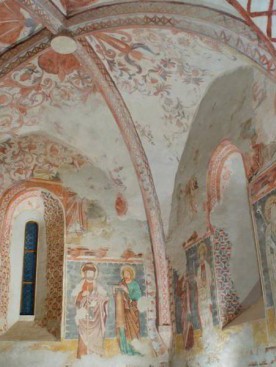The Calvinist Church – LónyaThe history of the village starts officially with a diploma issued in 1270 saying that the legendary viceroy, Bánk bán, bought the two villages called Lónya and presented them to his son-in-law, Simon. The later owners of the settlement were the Lónyai family, who took their names after this centre of their estate. Interestigly, for centuries, the traditional burial place of the family has been this village. Little is know, thought, about the church. Still, the register on the Papal Tenth kept by the archdeacon’s office in Zemplén mentions the Saint Peter and Paul church in Lónya. Thus, the church was already functional in the 1330s, a fact proved by the results of the art historical investigations, too. In its present form, the church is made up of two structural elements: a rectangular, single-bay nave (measuring 12 x 7 metres) and a square-based sanctuary (measuring 4 x 4 metres). The nave is higher than the sanctuary and the two roofs are also separate. On the western frontispiece, one can find a portal spanned by an archivolt consisting of lancet arches. Windows spanned by archivolts consisting of semi-circular arches were cut through the southern walls of both the nave and the sanctuary. The nave is not vaulted, and the chancel arch separating it from the sanctuary is a lancet arch. However, a groin vault ceiling covers the sanctuary, and the cornerstone of the former is a flat, undecorated disc. Later modifications were made by the Calvinists after they acquired the church. Still, their congregation was mentioned for the first time in 1595. They raised the floor level during the 18th century, ordered the pulpit decorated with stucco (the year 1776 is engraved on its baldachin) and the impressive belfry made by carpenters in 1781. The medieval church had not been built in a single period either. Wall explorations showed that the western wall suffered modifications. It is unclear whether the vaulting of the sanctuary stems from the first period or not. Earlier presumptions that the church was built during Bánk bán’s or Simon’s time – i.e., at the beginning of the 13th century – are rather questionable. It is more probable that the church was built a century later. Moreover, it was modified only in the 14th century. Since, later modifications were rather insignificant, a huge treasure represented by Gothic and Renaissance frescoes has been preserved under the layer of plaster. In 2000, the flooding of the river Tisza hit Lónya heavily. The Calvinist church suffered massive damages as well and it had to be restored. During restoration work, the mentioned treasure has been discovered. The beautiful mural paintings stem from three different periods: the Romanesque, the Gothic and the late Renaissance. The representations belonging to the Romanesque era are: Saint George on the southern wall of the nave, the three saints on the southern side of the chancel arch and ‘The Holy Virgin with the cloak’ on its northern side. These were presumably painted at the beginning of the 14th century. The dating of the second layer of paint applied when the entire sanctuary was decorated can be made on the basis of an inscription: ‘1413’. Usually, the third period is also determined on the basis of a lost inscription ‘1631’, a year when the Church was used already by the Calvinists. The restoration of the church was completed in 2008. Its aim was to present medieval and later, Calvinist architectural elements in harmonious unity. From a qualitative point of view, the murals in Lónya exceed by far other similar monuments in Hungary. Hence it is no wonder that they caused a huge sensation and are still very popular. |



















